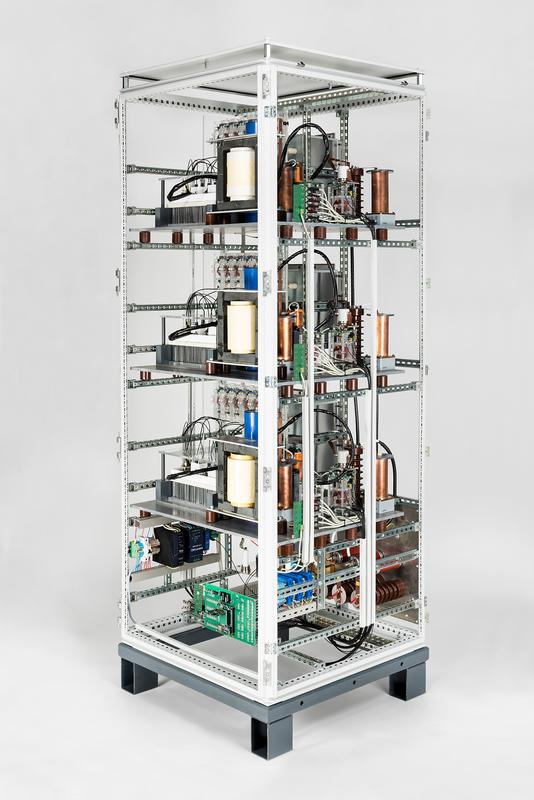New High-Voltage Silicon Carbide Inverter Enables Stabilization of Medium-Voltage Grids

The 100 kVA inverter with 15 kV silicon carbide transistors shown here was developed at Fraunhofer ISE for feed-in to the 10 kV medium-voltage grid. © Fraunhofer ISE
According to the current state of technology, power electronics are coupled to the electricity grid mainly in the low voltage range. For grid stabilization, power converters, so-called STATCOMs (Static Synchronous Compensators), are used to supply continuous inductive or capacitive reactive power.
The coupling to the medium voltage grid is affected by means of a 50 Hz transformer. The newly developed inverter from Fraunhofer ISE can now feed directly into the medium voltage grid without a transformer, due to the use of high voltage transistors made of silicon carbide (SiC). First component prototypes with a blocking voltage of 15 kV were used for this purpose.
Simpler System Concept and Higher Dynamics
For comparison, silicon transistors commercially available today have blocking voltages of up to only 6.5 kV. In this case, multilevel topologies with a high degree of complexity are required for feed-in to a 10 kV or 20 kV medium voltage grid. In addition silicon transistors have very high power losses.
On the other hand, silicon carbide (SiC) semiconductors have a higher blocking voltage, which reduces the number of components required for a converter. This increases not only the efficiency but also the compactness of the device.
Silicon carbide transistors also have very low switching energies, which allows for higher frequencies. As a result, the dimensions of the passive components can be reduced leading to increased savings. In addition, a transformerless compact inverter offers the possibility to upgrade the existing medium- voltage grid in urban locations.
A further advantage of this technology is the better control dynamics of the inverter. Due to the higher frequency, the inverter can act as an active filter to compensate for harmonics in the medium-voltage grid. With STATCOMS this is only possible to limited extent because of the low-pass effect of the 50 Hz transformer.
»The use of high-blocking SiC transistors, however, also presents us with new challenges,« says the project head Dirk Kranzer. »The transistors switch very fast. The extremely steep rate of voltage rise during switching can cause faults or also lead to partial or creeping discharges in the insulation. In developing the circuitry, large efforts must be made to minimize these undesirable effects. Before commercial implementation is possible, further technological developments are necessary, for example, in the power modules or in the inductive and capacitive components.«
The demonstrator for feed-in to the 10 kV grid has a power of 100 kVA. The frequency is 16 kHz, which is approximately ten times higher than in medium-voltage converters based on silicon semiconductors. Advanced high-voltage (15 kV / 10 A) silicon carbide power MOSFETs were used for the transistors. The inductive components were developed by the company and project partner »STS« (Spezial-Transformatoren-Stockach GmbH).
Future Power Electronics for Energy Technology
Besides stabilizing the medium-voltage grid, many more possible applications for high-voltage silicon carbide components exist. »For power electronics, we see a large potential for future applications in the medium-voltage range, « says Prof. Dr. Bruno Burger, group head of »New Components and Technologies« at Fraunhofer ISE. »In the future, totally new system architectures for renewable power plants, for example, large photovoltaic plants or wind farms in the megawatt range, are conceivable. The new technology also shows promise for applications in the railroad industry or large battery storage banks.«
In any case, the Department of Power Electronics and Grid Technologies at Fraunhofer ISE is well equipped to address future areas of application for power electronics in the medium-voltage grid, especially with respect to the energy transformation. At Fraunhofer ISE in Freiburg, a new medium-voltage laboratory in the multi-megawatt range is currently being set up.
The new inverter was developed in the project »HV-SiC« within the funding initiative »Future Electricity Grids« under the financial sponsorship of the German Federal Ministry of Education and Research (BMBF).
Fraunhofer ISE is presenting their newest developments in the area of power electronics at the PCIM Europe Conference in Nuremberg, Germany from June 5-7, 2018.
Media Contact
All latest news from the category: Power and Electrical Engineering
This topic covers issues related to energy generation, conversion, transportation and consumption and how the industry is addressing the challenge of energy efficiency in general.
innovations-report provides in-depth and informative reports and articles on subjects ranging from wind energy, fuel cell technology, solar energy, geothermal energy, petroleum, gas, nuclear engineering, alternative energy and energy efficiency to fusion, hydrogen and superconductor technologies.
Newest articles

First-of-its-kind study uses remote sensing to monitor plastic debris in rivers and lakes
Remote sensing creates a cost-effective solution to monitoring plastic pollution. A first-of-its-kind study from researchers at the University of Minnesota Twin Cities shows how remote sensing can help monitor and…

Laser-based artificial neuron mimics nerve cell functions at lightning speed
With a processing speed a billion times faster than nature, chip-based laser neuron could help advance AI tasks such as pattern recognition and sequence prediction. Researchers have developed a laser-based…

Optimising the processing of plastic waste
Just one look in the yellow bin reveals a colourful jumble of different types of plastic. However, the purer and more uniform plastic waste is, the easier it is to…



